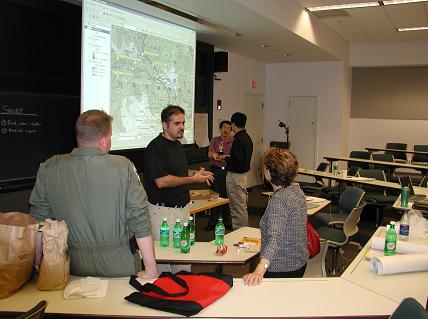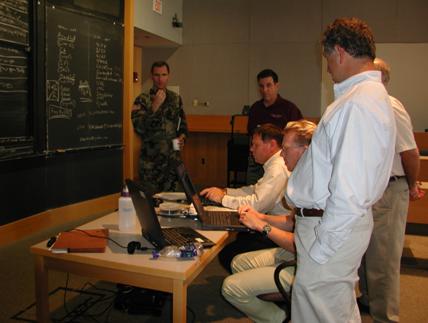

The MIT motto, “Mens et Manus,” or, “Mind and Hand,” took on new meaning for
the 85 members of the current Sloan Fellows cohort on 5 and 6 August, as the
fellows were immersed in a challenging, high pressure, leadership simulation
that required them to exercise their leadership skills in a rapidly evolving and
ambiguous environment. The simulation replicated the environment of 1995 Bosnia,
and the initial implementation of the Dayton Peace Accords. This year the
Fellows, faculty, and staff were joined by members of the MIT Department of
Military Science faculty, retired, and reserve component military officers.
The Paul Revere Battalion, MIT’s Army ROTC program, seized the opportunity to
lead one of the Sloan School’s leadership course exercises. The Army now teaches
leadership at the undergraduate, graduate, and executive levels at MIT.
Assistant Professor of Military Science, Major Sam Peffers, galvanized support
for and led the Army effort to participate in the “flagship” executive MBA Sloan
Fellows program furthering the ROTC outreach efforts and advancing the Army ROTC
brand in the leadership arena.
The active and retired military officers were: Colonel (Retired) Allard, a
veteran with over 30 years of active duty experience and former Public Affairs
Officer for the NATO Implementation Force (IFOR) in Bosnia during 1995; Major
Peffers, Assistant Professor of Military Science at MIT and former
Observer/Controller at two of the Army’s three Combat Training Centers; Major
Crosier, recent Army Command and General Staff College graduate and a China
Foreign Area Officer; Major Balogh, a bomber and tanker pilot of the Washington
State Air National Guard, who is a leadership and management consultant in
civilian life; Major (Retired) Cancellieri, a career Infantry officer with
extensive operational and combat experience, who spent 15 of 20 years in the
service stationed outside the Continental United States; and Captain Sullivan, a
Blackhawk helicopter pilot and former member of the 82nd Airborne Division,
recently returned from two years in the Republic of Korea, where he commanded an
Aviation company.
ROTC Department Head Lieutenant Colonel Brian Baker stated that he is “excited
about the expansion of our involvement in all-things related to leadership
development at MIT. Leadership is an influence relationship among leaders and
followers who intend real changes that reflect their shared purposes, akin to
those shared by the Army and the Sloan School. Our Army has been developing
leaders for centuries. The past three Professors of Practice in Leadership at
the Sloan School were Army trained; John Reed, Dana Mead, and Marshall Carter
all received their initial leader development training from the Army, served
their nation in the Armed Forces, and went on to be CEOs of Fortune 500
companies. Baker went on to say that the most recent Presidents emeritus at
Harvard and MIT, Neil Rudenstine and Paul Gray both earned commissions through
ROTC and both served as captains in the Army. Put another way, the top two
academic leaders in America, some say, the Presidents of MIT and Harvard got
their initial leader development training from the Army.”
The simulation required the Sloan Fellows to quickly establish an organizational
structure, plan for a complex series of requirements, and respond with agility
to an ambiguous and rapidly developing situation. The Fellows role played a
variety of governmental, non-governmental, and NATO military organizations, all
engaged in attempting to establish initial local stability and averting a major
humanitarian crisis. Each of the organizations represented, and staffed by a
student work group of two to four Sloan Fellows, brought a unique set of
priorities and resources to the undertaking. There was no pre-established
leadership hierarchy or organizational structure dictated to the Fellows, and a
significant portion of the exercise was devoted to the Fellows learning to work
together with their peers to share available resources while balancing
priorities and objectives that were at some times competing and at others
complimentary. Two groups of Fellows also role played two ethnic communities
within the local population, one of which had recently displaced the other.
Active and former military officers provided background information,
observation, and feedback to the Fellows as well as the faculty and staff of the
Sloan School. The officers also assisted in operating the simulation’s control
center which orchestrated interaction between the exercise participants in the
live world and the constructive environment of the simulation. The Sloan Fellows
found the military officers’ experience and insights particularly valuable in
developing potential courses of action to meet their basic requirements and
respond to unexpected circumstances encountered during the execution phase of
the simulation. The military officers found the use of the simulation in a
strictly academic setting strikingly similar to what the Army refers to as a,
“Command Post Exercise.” Both operations share several elements in common,
though their educational and training objectives are quite different. One of the
officers was invited to lead the concluding after action review.
Faculty director of the MIT Leadership Center, Professor Deborah Ancona said of
the event, "The presence of six military officers in full uniform lent drama and
realism to the simulation. The officers shared their amazing experience and
knowledge enhancing the situation for both participants and faculty. We are
extremely grateful for their participation and hope that we find more ways to
collaborate in the future." Lieutenant Colonel Baker commented, “I think both
organizations benefit substantially from our collaboration.” Baker cited the,
“synergy,” between the Sloan School and ROTC Department, “the joint action of
agents, that when taken together increase each other’s effectiveness; we now
teach 15.305, Leadership and Management; 15.952, an IAP course offering on
leadership; and collaborate with the Sloan Fellows Program.” He concluded, “The
simulation was a wonderful opportunity for the world’s premier leadership
development organization, the United States Army, to exchange ideas with one of
the world’s best academic leadership and management institutions.”
 |
 |
| Major Balogh (left), and Prof. Deborah Ancona (right), Faculty Director of the MIT Leadership Center, work with Fellows portraying displaced persons (photo by Jennifer Mapes). | Simulation control room, from left to right: Major Peffers, Colonel Allard, Major Cancellari, Mr. Newsome, Prof. John Carroll, Stephen J. Sacca, SF ’90, Director MIT Sloan Fellows Program (photo by Jennifer Mapes). |